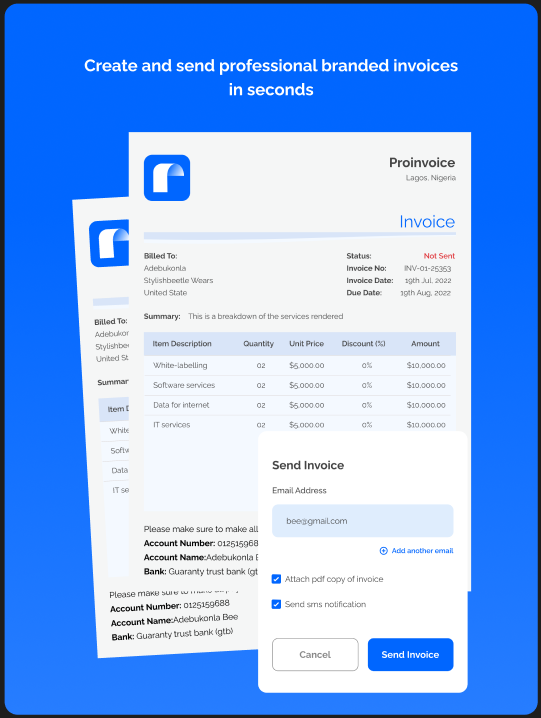Why Knowing Your Numbers is Key to USA Small Business Growth: In the competitive landscape of American small business, gut feeling and intuition can only take you so far. The difference between businesses that thrive and those that merely survive often comes down to one critical factor: knowing your numbers.
According to the U.S. Small Business Administration, roughly 50% of small businesses fail within their first five years. While there are many contributing factors to business failure, poor financial management consistently ranks among the top reasons. The businesses that succeed aren’t necessarily those with the best products or the most innovative ideas—they’re the ones whose owners understand their financial health and make data-driven decisions.
Stay organized as you grow. Use ProInvoice to manage billing and client relationships with ease.
Yet surprisingly, many small business owners in the USA operate without a clear picture of their financial situation. They may know roughly how much money is coming in, but lack visibility into profit margins, cash flow patterns, customer acquisition costs, or other critical metrics that drive sustainable growth.
This article explores why financial literacy is non-negotiable for small business success and how you can start mastering your numbers today.
The Cost of Financial Ignorance
Operating a business without understanding your numbers is like driving a car blindfolded. You might move forward for a while, but eventually, you’ll crash.
Consider this scenario that plays out thousands of times across the USA: A small business appears successful on the surface. Revenue is growing, customers are happy, and the owner is working hard. But beneath the surface, profit margins are razor-thin, expenses are creeping up faster than revenue, and cash flow gaps are being covered by credit cards. By the time the owner realizes there’s a problem, the business is already in crisis mode.
Financial ignorance manifests in several dangerous ways. Business owners may underprice their products or services because they don’t know their true costs, continue offering unprofitable products because they don’t track individual product performance, miss early warning signs of cash flow problems, make poor investment decisions without ROI analysis, and fail to plan for taxes, leading to devastating surprise bills.
Perhaps most critically, owners who don’t know their numbers can’t identify growth opportunities. They can’t tell which customers are most profitable, which marketing channels deliver the best return, or which aspects of their business deserve more investment.
Essential Numbers Every Small Business Owner Must Track
Financial management doesn’t require a degree in accounting, but it does require monitoring specific key performance indicators that tell the story of your business health.
Revenue and Revenue Growth might seem obvious, but many business owners track only total revenue without breaking it down by product, service, customer segment, or time period. Understanding revenue patterns helps you identify trends, seasonal fluctuations, and growth opportunities. Track monthly recurring revenue for subscription models, average transaction value, and year-over-year growth rates.
Gross Profit Margin tells you how much money you keep after paying for the direct costs of producing your product or service. Calculate it by subtracting cost of goods sold from revenue, then dividing by revenue. If you’re selling a product for $100 that costs $60 to produce, your gross profit margin is 40%. This metric is crucial for pricing decisions and understanding which offerings are actually profitable.
Stay organized as you grow. Use ProInvoice to manage billing and client relationships with ease.
Net Profit Margin goes further by accounting for all expenses, including overhead, salaries, marketing, and administrative costs. This is your true profitability. Many businesses have healthy gross margins but struggle with profitability because operating expenses are too high. In the USA, average net profit margins vary significantly by industry, typically ranging from 5% to 20% for small businesses.
Cash Flow is the lifeblood of your business. You can be profitable on paper but still go bankrupt if you run out of cash. Track your cash position daily or weekly, understand your cash conversion cycle (how long it takes from spending money to receiving payment), and maintain a rolling 13-week cash flow forecast. Remember: revenue is vanity, profit is sanity, but cash is reality.
Accounts Receivable Aging shows how much money customers owe you and how long invoices have been outstanding. The longer an invoice goes unpaid, the less likely you are to collect it. Track your average collection period and percentage of invoices over 30, 60, and 90 days old. Using a professional invoice generator helps ensure your invoices are clear, professional, and easy for customers to pay promptly.
Customer Acquisition Cost (CAC) measures how much you spend to acquire a new customer. Calculate it by dividing total sales and marketing expenses by the number of new customers acquired in that period. If you spent $5,000 on marketing and gained 50 customers, your CAC is $100.
Customer Lifetime Value (CLV) estimates the total revenue you’ll earn from a customer over the entire relationship. Compare CLV to CAC to ensure you’re spending wisely on customer acquisition. A healthy ratio is typically 3:1 or higher—meaning customers should generate at least three times what it costs to acquire them.
Break-Even Point is the amount of revenue needed to cover all your costs. Knowing this number helps you set realistic sales targets and understand how much buffer you have during slow periods. Calculate it by dividing fixed costs by your contribution margin (selling price minus variable cost per unit).
How Financial Visibility Drives Strategic Decisions
When you have real-time visibility into your financial metrics, decision-making transforms from guesswork to strategy. Let’s look at how knowing your numbers enables better business decisions.
Pricing Strategy becomes scientific rather than arbitrary. By understanding your costs, desired profit margins, and customer willingness to pay, you can price competitively while maintaining profitability. Many small business owners underprice their offerings because they don’t accurately calculate all costs, including their own time.
Stay organized as you grow. Use ProInvoice to manage billing and client relationships with ease.
Resource Allocation improves dramatically when you know which products, services, or customer segments are most profitable. Instead of spreading resources thin, you can double down on what works and eliminate or improve what doesn’t. This focus accelerates growth and improves overall profitability.
Cash Flow Management becomes proactive rather than reactive. When you forecast cash flow 90 days out, you can anticipate shortfalls and take action before crisis hits. You might adjust payment terms with vendors, accelerate collection efforts, or arrange a line of credit during anticipated lean periods.
Growth Investment can be made confidently when you understand your unit economics. If you know that each new customer generates $1,000 in lifetime value and costs $300 to acquire, you can confidently invest in growth because the math works. Without these numbers, growth investments are simply gambles.
Tax Planning shifts from yearly scrambles to strategic year-round management. By tracking income and expenses continuously, you can estimate tax liability quarterly, make estimated payments to avoid penalties, and time major purchases for optimal tax benefits.
Common Financial Mistakes That Hold USA Small Businesses Back
Even business owners who pay attention to finances often make critical mistakes that limit growth potential.
Mixing Personal and Business Finances is one of the most common mistakes among small business owners. This makes it nearly impossible to understand true business profitability, complicates tax preparation, eliminates important legal protections, and creates problems if you ever want to sell the business. Open a separate business bank account and credit card from day one, and treat your business as a distinct financial entity.
Failing to Pay Yourself a Salary might seem noble—reinvesting everything back into the business—but it distorts your true costs and profitability. Your time has value and should be accounted for in your business expenses. Without paying yourself, you don’t know if your business model actually works or if you’re just subsidizing an unprofitable business with free labor.
Neglecting to Build Emergency Reserves leaves you vulnerable to unexpected challenges. Financial experts recommend businesses maintain three to six months of operating expenses in reserve. This provides a buffer during slow periods, allows you to weather unexpected expenses without taking on high-interest debt, and gives you freedom to pass on poor-fit opportunities without desperation.
Chasing Revenue Without Considering Profitability is another dangerous trap. Not all revenue is good revenue. A project that brings in $50,000 but costs $48,000 to deliver and causes immense stress might be worse than a $20,000 project that costs $10,000 and runs smoothly. Focus on profitable revenue, not just top-line growth.
Ignoring the Time Value of Money leads many businesses to offer extended payment terms without considering the cost. When you complete work today but receive payment 60 or 90 days later, you’re essentially providing an interest-free loan while you still need to cover payroll, rent, and other expenses immediately.
Making Decisions Based on Bank Balance rather than actual profitability is tempting but dangerous. Your bank balance reflects timing of income and expenses, not true financial health. You might have a healthy balance today because you just received payment for next month’s subscription services, but those funds are already committed to delivering that service.
How Technology Simplifies Financial Management
The good news is that modern technology has made financial tracking infinitely easier than it was even a decade ago. Small business owners no longer need expensive accountants or complex spreadsheets to maintain financial visibility.
Cloud-based accounting software automatically categorizes expenses, tracks income, and generates reports with minimal manual input. These platforms integrate with your bank accounts and credit cards to provide real-time financial snapshots.
Digital payment systems reduce the time between completing work and receiving payment, improving cash flow. They also create automatic records of all transactions, simplifying bookkeeping and tax preparation.
Invoicing platforms ensure you bill promptly and professionally while tracking outstanding payments automatically. This is where solutions like ProInvoice become invaluable for growing businesses.
How ProInvoice Helps You Master Your Business Numbers
ProInvoice is designed specifically to solve the financial visibility challenges facing small businesses in the USA and beyond. Rather than treating invoicing as an isolated task, ProInvoice integrates it into your overall financial management strategy.
Click to download the Proinvoice mobile app now to manage your invoices anytime, anywhere with ease!
Real-Time Revenue Tracking gives you instant visibility into how much you’ve billed, how much you’ve collected, and how much is still outstanding. The dashboard provides at-a-glance metrics that answer critical questions: Are we on track to hit our monthly revenue target? Which customers haven’t paid? What’s our average time to payment?
Automated Invoice Generation ensures you never delay billing due to the hassle of creating invoices. Register for ProInvoice and you can create professional invoices in under a minute, then send them directly to clients with automated reminders. This acceleration in your billing cycle directly improves cash flow—the faster you invoice, the faster you get paid.
Payment Tracking and Reminders eliminate the awkward dance of chasing late payments. ProInvoice automatically sends friendly reminders before and after due dates, so you don’t have to remember or worry about seeming pushy. This systematic approach dramatically improves collection rates without damaging client relationships.
Financial Reporting transforms your invoicing data into actionable insights. See which clients are most profitable, identify seasonal revenue patterns, track your average payment time, and monitor your accounts receivable aging—all without manual spreadsheet work. These reports help you make data-driven decisions about which clients to pursue, what services to emphasize, and where to focus your growth efforts.
Mobile Accessibility means you can manage your business finances anywhere. The ProInvoice mobile app lets you create and send invoices on-site, check payment status between meetings, and respond to client questions immediately. This flexibility is crucial for busy entrepreneurs who can’t be chained to a desk but still need full financial visibility.
Integration with Your Financial Workflow makes ProInvoice a central hub rather than another disconnected tool. Export data to your accounting software, share reports with your bookkeeper or tax professional, and maintain a complete financial record that simplifies tax time and financial planning.
For small businesses serious about growth, ProInvoice eliminates the gap between doing the work and understanding the financial results. Instead of waiting until month-end to see how you performed, you have real-time visibility that enables proactive decision-making.
Building a Financial Dashboard for Your Business
While comprehensive software helps, you can start improving financial visibility today by creating a simple dashboard that tracks your most critical metrics.
Choose five to seven key numbers that matter most for your specific business. Review them weekly, not just monthly or quarterly. Frequent review helps you spot trends and problems early. Create a simple spreadsheet or use a tool that automatically pulls in this data and displays it visually through charts and graphs.
Your dashboard might include current cash balance, revenue for the month to date versus target, outstanding accounts receivable, current month profit margin, and customer acquisition cost for recent marketing campaigns. The specific metrics matter less than the discipline of tracking them consistently.
Set up a recurring calendar appointment to review your dashboard every Monday morning or Friday afternoon. Make this non-negotiable time to understand where your business stands. Over time, you’ll develop an intuition for normal patterns, making anomalies immediately obvious.
Click to download the Proinvoice mobile app now to manage your invoices anytime, anywhere with ease!
Developing Financial Literacy as a Business Owner
If numbers aren’t your strength, don’t panic. Financial literacy is a learnable skill, and you don’t need to become an accountant to effectively manage your business finances.
Start by understanding your financial statements. Learn what your profit and loss statement reveals about profitability, how your balance sheet shows your financial position at a point in time, and why your cash flow statement explains the movement of money through your business. You don’t need to prepare these documents yourself, but you should be able to read and interpret them.
Take a basic business finance course through organizations like SCORE, your local Small Business Development Center, or online platforms. Even a few hours of structured learning can dramatically improve your financial confidence and decision-making.
Work with professionals strategically. You don’t need a full-time CFO, but consulting with a good accountant quarterly can help you interpret your numbers and plan strategically. Many accountants offer advisory services beyond basic bookkeeping and tax preparation.
Join peer groups or masterminds with other business owners. Discussing financial strategies and challenges with peers often provides practical insights that are more immediately applicable than academic learning. Plus, it normalizes the financial challenges every business faces and reminds you that you’re not alone in learning this skill.
Making Financial Reviews a Habit
The most important step in knowing your numbers is making financial review a consistent habit rather than an occasional panic-driven event. Here’s how successful business owners build this discipline.
Daily check-ins should take just five minutes. Look at your bank balance and any payments received. This keeps you connected to your financial reality and helps you spot any unusual transactions immediately.
Weekly reviews should take 15-30 minutes. Review your dashboard metrics, check outstanding invoices, look at the week’s expenses, and assess progress toward monthly goals. This is where you make small course corrections before they become big problems.
Monthly deep dives should take a few hours. Review full financial statements, analyze variances from budget, assess profitability by product or service line, and plan the next month’s financial priorities. This is strategic time that pays dividends in improved decision-making.
Quarterly strategic sessions should involve reviewing year-to-date performance against annual goals, updating your financial forecasts, planning major investments or changes, and meeting with your accountant or financial advisor. These sessions keep you focused on long-term strategy rather than just day-to-day survival.
Conclusion: Financial Mastery as a Competitive Advantage
In the USA’s competitive small business environment, knowing your numbers isn’t just about avoiding failure—it’s about creating a sustainable competitive advantage. While your competitors are making decisions based on feelings and guesses, you can make strategic choices grounded in data.
Financial literacy transforms every aspect of your business. You price more confidently, invest more strategically, grow more sustainably, and sleep better at night knowing exactly where you stand. The time you invest in understanding your numbers returns multiples in improved profitability, reduced stress, and accelerated growth.
The journey to financial mastery doesn’t require an MBA or a background in finance. It simply requires commitment to tracking the right metrics, reviewing them consistently, and using that data to make better decisions. With modern tools like ProInvoice handling the mechanical aspects of financial tracking, you can focus your energy on strategic analysis and action rather than data entry and calculation.
Start today. Choose your key metrics, set up your tracking system, and commit to weekly reviews. Your future self—and your thriving business—will thank you for the discipline you build now. Remember: in business, what gets measured gets managed, and what gets managed gets improved.
The difference between businesses that struggle and those that thrive often comes down to this simple principle. Which side will you be on?
Click to download the Proinvoice mobile app now to manage your invoices anytime, anywhere with ease!















